Emancipation of the arts


Buchpräsentation
Am 7. Oktober 2021 präsentierte der Kunst-ARCHIV-Raum in einer Hybrid-Veranstaltung gemeinsam mit der Universität für Musik und darstellende Kunst Wien, der Universität für angewandte Kunst Wien und der Kunstuniversität Graz die Publikation “Auf dem Weg zur Kunstuniversität: das Kunsthochschul-Organisationsgesetz von 1970“.
1970 wurden die damaligen Akademien für Musik und darstellende Kunst in Graz, Salzburg und Wien sowie die Akademie für angewandte Kunst in Wien zu Hochschulen. 50 Jahre später starteten die Archive der vier Kunstuniversitäten ihr Buch-Projekt und legten im Herbst 2021 das Ergebnis der ersten gemeinsamen Forschungsarbeit vor. Die Publikation ist der historischen Aufarbeitung der ersten Schritte in die Autonomie gewidmet, wie etwa der Demokratisierung der Hochschulen sowie der Gleichstellung von Kunst und Wissenschaft.
In vielfältigen Beiträgen wird ein Bogen gespannt von den Ursprüngen und Entwicklungen der Konservatorien im 19. und 20. Jahrhundert zum Entstehungsprozess und den Herausforderungen der neuen Strukturen an den einzelnen Hochschulen, bis zu den Auswirkungen, Entwicklungen und Perspektiven, die diese mit sich brachten und auch heute noch bringen. Sie gehen den Anfängen von Selbstbestimmung, Mitsprache und Gleichstellung in ihren Institutionen nach – allesamt brisante Themen, die auch aktuell wieder an den Universitäten diskutiert werden.
Die Präsentation fand zeitgleich in den drei beteiligten Städten statt und die von den einzelnen Universitäten gestalteten Teile wurden via Video-Konferenz jeweils an die anderen Institutionen übertragen.
Die Publikation ist im Kunst-ARCHIV-Raum der Universität Mozarteum Salzburg erhältlich.
were drawn up, and the required level for admission to a training program was greatly
raised. As I […] have been on the road internationally, I know about the enormous
image gain that the Mozarteum
was able to lucre from its elevation to a conservatory." This is how Paul Roczek, former violin professor, vice rector and director of the International Summer Academy of the Mozarteum University, remembers the upswing brought about by becoming a university in Salzburg. An upswing that above all the first rector of the new Mozarteum University, Paul von Schilhawsky, was able to bring about through his Europe-wide contacts. The students also made lasting use of the new opportunity to have their say: in preparation for the new law and the transformation of the music academies into universities, the ÖH established itself at the Mozarteum. The structural changes created at the Mozarteum University, in addition to the establishment of the first new institutes, the basis for the new Artistic Department for Art Education. Thus, as of 1975, it was the only Austrian art college to unite all three branches of the arts: music, performing arts and fine arts. A unique selling point that continues to this day. An additional special feature of art education in Salzburg was that it was endowed with its own artistic professorships from the very beginning, an exception in the context of artistic teacher training programs to this day. The challenges on the way to the founding of the Department of Art Education at the Mozarteum are reviewed in detail for the first time in the publication by the contribution of Hildegard Fraueneder. A Bridge to the Future "On the Way to the Art University: the Art University Organization Act of 1970" spans in diverse contributions an arc from the origins and developments of Austrian art academies in the 19th and 20th centuries, through the process of creation and the challenges of the new structures at the individual universities, to the effects, developments and perspectives that these brought and still bring today. They trace the beginnings of self-determination, voice, and equality in their institutions: similar to the explosive issues that are again currently being discussed at universities. (First published in Uni-Nachrichten / Salzburger Nachrichten on October 6, 2021)



